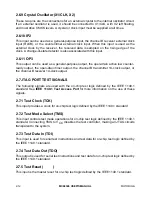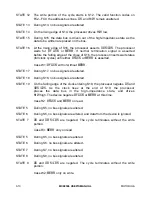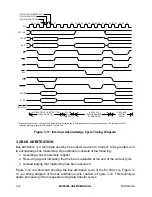
MOTOROLA
MC68306 USER'S MANUAL
2- 9
2.1.15 Lower-Byte Write (
LW
)
This signal is a combination of R/
W
low and
LDS
low for writing the lower-byte of a 16-bit
port. This signal simplifies memory system design by explicitly signalling that data is valid
on the lower portion of the data bus on a write operation.
LW
is also decoded for external
bus masters.
2.1.16 Output Enable (
OE
)
OE
is a combination of R/
W
high and an active data strobe (
UDS
or
LDS
).
OE
is also
decoded for external bus masters.
2.1.17 Reset (
RESET
)
The external assertion of this bi-directional, open-drain signal can start a system
initialization sequence by resetting the processor. The processor assertion of
RESET
(from executing a RESET instruction) resets all external devices of a system without
affecting the internal state of the processor. The interaction of internal and external
RESET
, and the
HALT
signal is described in paragraph 3.5 Reset Operation.
2.2 CHIP SELECT SIGNALS
These eight three-state signals provide address decodes with programmable base and
range.
CS7
–
CS4
are only available in chip select mode (AMODE bit =1).
CS3–CS0
are
always available.
2.3 DRAM CONTROLLER SIGNALS
The following signals are used to control an external DRAM for the MC68306.
2.3.1 Column Address Strobe (
CAS1
–
CAS0
)
These three-state signals provide column address strobe timing for external DRAM. CAS0
controls data lines D15–D8 and CAS1 controls D7–D0.
2.3.2 Row Address Strobe (
RAS1
–
RAS0
)
These three-state signals provide row address strobe timing for external DRAM. Each
RAS controls a separate bank of DRAM.
2.3.3 DRAM Write Signal (
DRAMW
)
This signal provides write control for external DRAM.
2.4 INTERRUPT CONTROL AND PARALLEL PORT SIGNALS
The following signals are used for interrupt control on the MC68306.
















































